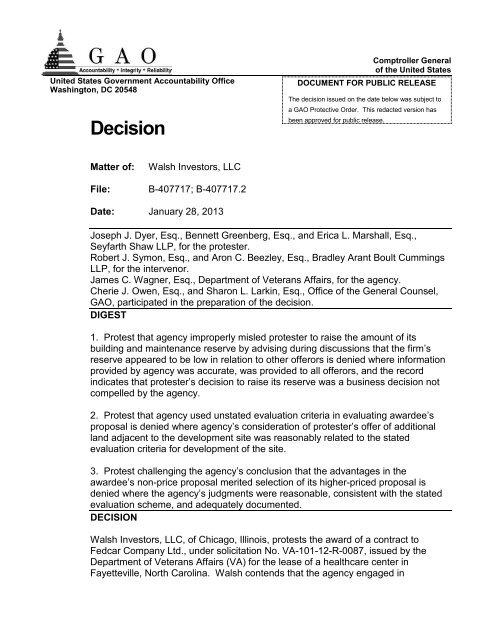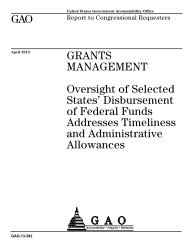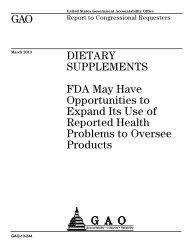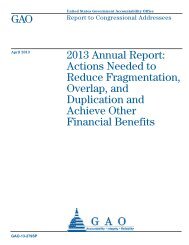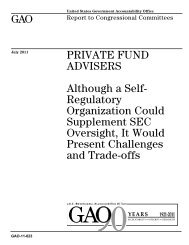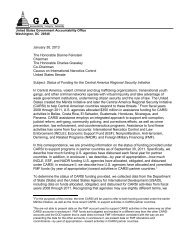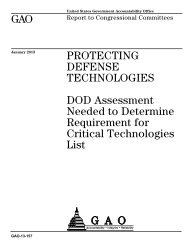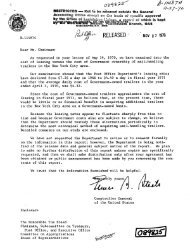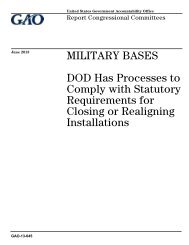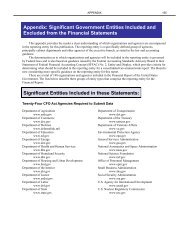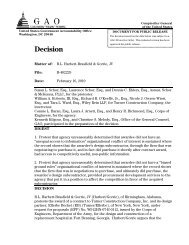PDF, 9 pages - US Government Accountability Office
PDF, 9 pages - US Government Accountability Office
PDF, 9 pages - US Government Accountability Office
Create successful ePaper yourself
Turn your PDF publications into a flip-book with our unique Google optimized e-Paper software.
United States <strong>Government</strong> <strong>Accountability</strong> <strong>Office</strong><br />
Washington, DC 20548<br />
Decision<br />
Comptroller General<br />
of the United States<br />
DOCUMENT FOR PUBLIC RELEASE<br />
The decision issued on the date below was subject to<br />
a GAO Protective Order. This redacted version has<br />
been approved for public release.<br />
Matter of:<br />
File:<br />
Walsh Investors, LLC<br />
B-407717; B-407717.2<br />
Date: January 28, 2013<br />
Joseph J. Dyer, Esq., Bennett Greenberg, Esq., and Erica L. Marshall, Esq.,<br />
Seyfarth Shaw LLP, for the protester.<br />
Robert J. Symon, Esq., and Aron C. Beezley, Esq., Bradley Arant Boult Cummings<br />
LLP, for the intervenor.<br />
James C. Wagner, Esq., Department of Veterans Affairs, for the agency.<br />
Cherie J. Owen, Esq., and Sharon L. Larkin, Esq., <strong>Office</strong> of the General Counsel,<br />
GAO, participated in the preparation of the decision.<br />
DIGEST<br />
1. Protest that agency improperly misled protester to raise the amount of its<br />
building and maintenance reserve by advising during discussions that the firm’s<br />
reserve appeared to be low in relation to other offerors is denied where information<br />
provided by agency was accurate, was provided to all offerors, and the record<br />
indicates that protester’s decision to raise its reserve was a business decision not<br />
compelled by the agency.<br />
2. Protest that agency used unstated evaluation criteria in evaluating awardee’s<br />
proposal is denied where agency’s consideration of protester’s offer of additional<br />
land adjacent to the development site was reasonably related to the stated<br />
evaluation criteria for development of the site.<br />
3. Protest challenging the agency’s conclusion that the advantages in the<br />
awardee’s non-price proposal merited selection of its higher-priced proposal is<br />
denied where the agency’s judgments were reasonable, consistent with the stated<br />
evaluation scheme, and adequately documented.<br />
DECISION<br />
Walsh Investors, LLC, of Chicago, Illinois, protests the award of a contract to<br />
Fedcar Company Ltd., under solicitation No. VA-101-12-R-0087, issued by the<br />
Department of Veterans Affairs (VA) for the lease of a healthcare center in<br />
Fayetteville, North Carolina. Walsh contends that the agency engaged in
misleading discussions, considered unstated evaluation criteria, and made an<br />
unreasonable tradeoff decision.<br />
We deny the protest.<br />
BACKGROUND<br />
On April 9, 2012, the VA issued the solicitation for offers (SFO) seeking offerors to<br />
provide a 20-year lease of approximately 250,000 net usable square feet of space<br />
at a pre-determined site located in Fayetteville, North Carolina. The successful<br />
offeror will construct a new building on the site that will house a VA healthcare<br />
center. Agency Report (AR), Tab F1, SFO, at 11. The solicitation informed offerors<br />
of the agency’s minimum requirements with regard to the development of the<br />
building and land, and the services to be provided.<br />
The SFO set forth the following evaluation factors in descending order of<br />
importance: (1) price, measured in annual price per net usable square foot,<br />
including any option period; (2) technical quality, including the quality of the building<br />
and the design concept; (3) the offeror’s qualifications, including past performance;<br />
and (4) the adequacy and efficiency of the operations and maintenance plans. Id.<br />
at 20. The solicitation explained that the non-price factors, when combined, were<br />
approximately equal in importance to the price factor. Id.<br />
With regard to the technical quality evaluation factor, the solicitation listed three<br />
sub-factors: (1) quality of building and design concept; (2) quality of site<br />
development; and (3) site physical security. Id. at 22-23. Under the first subfactor,<br />
quality of building and design concept, the agency stated that it would consider the<br />
following: architectural concept; building design; sustainable design and energy<br />
efficiency; and quality of construction materials. Id.<br />
Under the second technical subfactor, quality of site development, the solicitation<br />
specified that the agency would consider, among other things, the offerors’<br />
development of the site to accommodate the VA’s conceptual building footprint,<br />
including the required setbacks, the ingresses and egresses to and from the<br />
entrances, traffic patterns to maximize flow of vehicles to and from the main<br />
thoroughfare, and how the landscaping design fits the surrounding areas. Id. at 23.<br />
With regard to the evaluation of price, the solicitation stated that prices would be<br />
evaluated on the basis of the annual shell rental rate per net usable square foot. Id.<br />
at 21.<br />
The VA received offers from twenty-one firms, including Walsh and Fedcar, by the<br />
closing date of June 5, 2012. After initial evaluations, the agency established a<br />
competitive range consisting of eleven offerors with which the agency conducted<br />
discussions. Contracting <strong>Office</strong>r’s Statement at 1. During discussions, the agency<br />
Page 2<br />
B-407717, B-407717.2
advised each offeror of how different aspects of its price proposal related to the<br />
average prices of all competitive range offerors. Specifically, the agency’s notes of<br />
its discussions state:<br />
We gave a general review of lines 1-27 vs. the averages of the other<br />
offers. We then reviewed the insurance, maintenance and reserve[,]<br />
and management lines. Again we compared the offered price to the<br />
average of the other offers.<br />
-Then we utilized the abstract of offers to tell each offeror how they<br />
related to the mean average of the price elements that we analyzed.<br />
-We told each offeror how the average cost of [certain listed] items<br />
related to their offered price.<br />
AR, Tab D1, Negotiation Meeting Notes, at 2 (notes from discussions with Walsh);<br />
see also, id. at 6 (notes from discussions with Fedcar).<br />
As relevant here, with regard to Walsh’s reserve, the agency stated that Walsh’s<br />
reserve of $[deleted] was low compared to the average. 1 Id. at 2. Similarly, the<br />
agency advised Fedcar that its reserve of $[deleted] was low in comparison to the<br />
average. Id. at 6; see AR, Tab C1, Abstract of Initial Offers, at 1.<br />
After engaging in discussions, the agency requested that offerors submit their final<br />
proposal revisions (FPR). As relevant here, Walsh’s FPR included a building<br />
maintenance reserve of $[deleted], which was an increase of $[deleted] over the<br />
amount of the reserve in its initial proposal. Fedcar’s FPR included a building<br />
maintenance reserve of $[deleted], which was an increase of $[deleted] over the<br />
amount of the reserve in its initial proposal. AR, Tab C3, Abstract of FPR Offers,<br />
at 1.<br />
In evaluating the non-price evaluation factors, the agency assigned weighted point<br />
scores and ranked each offeror’s proposal. As relevant here, Fedcar’s final<br />
proposal was ranked first under the non-price factors with a score of 41.21, while<br />
Walsh’s final proposal was ranked second with a score of 38.27. AR, Tab B4, TEB<br />
Score Summary, at 2; Contracting <strong>Office</strong>r’s Statement at 3. With regard to price,<br />
Fedcar was ranked fifth with a net present value fully-serviced rental rate of $29.78<br />
per net usable square foot, while Walsh’s proposal was ranked fourth in the price<br />
evaluation with a rate of $28.90. 2 AR, Tab E, Price Negotiation Memorandum,<br />
at 34.<br />
1 The average reserve proposed by offerors was $328,916.72. AR, Tab C1,<br />
Abstract of Initial Offers, at 1.<br />
2 During the pendency of this protest, the agency submitted a revised abstract of<br />
FPR prices, which reflects that Fedcar was ranked fourth in the price evaluation and<br />
Walsh was ranked fifth. AR, Tab C3, Abstract of FPR Offers, at 1 (dated Nov. 16,<br />
(continued...)<br />
Page 3<br />
B-407717, B-407717.2
In the contracting officer’s best value analysis, he noted that Fedcar’s proposal<br />
“presented a building design that featured many well thought out elements that<br />
enhanced the building’s function, a maintenance plan that showed a full<br />
understanding of the health care requirements and the financial ability to perform.”<br />
AR, Tab E, Price Negotiation Memorandum, at 33. The contracting officer<br />
acknowledged that Fedcar’s proposal was ranked first in the technical evaluation,<br />
fifth in the price evaluation, and first overall. Id.<br />
The contracting officer also noted that Fedcar had proposed to provide an additional<br />
five acres of land adjacent to the VA’s pre-selected site. The contracting officer<br />
described the benefits of the additional land as follows:<br />
-Increased visibility and frontage<br />
-An additional point of ingress/egress at the Old Raeford Rd/Raeford<br />
Rd intersection<br />
-A site access point at an existing traffic signal<br />
-Provide significantly improved on-site traffic circulation<br />
-Allow an overall site adjustment to shift planned perimeter parking<br />
from under the existing power-line easement<br />
AR, Tab E, Price Negotiation Memorandum, at 34.<br />
In his source selection decision, the contracting officer acknowledged that Fedcar<br />
was ranked fifth in price, but also noted that Fedcar’s proposal offered the lowest<br />
unserviced first-year rental rate. Id. at 34. The contracting officer considered that<br />
Walsh ranked second in the technical evaluation and fourth in the price evaluation,<br />
but found that the multiple benefits associated with Fedcar’s proposal to provide<br />
additional acreage outweighed the price difference between Fedcar’s and Walsh’s<br />
proposal. Id. Therefore, the contracting officer determined that Fedcar’s proposal<br />
(...continued)<br />
2012). In an e-mail, the agency explained that, during its review of the file, it made<br />
administrative revisions to the abstract of offers. E-mail from VA Attorney, Nov. 21,<br />
2012. In the revised version, Fedcar’s net present value fully-serviced rental rate<br />
was $28.83 per net usable square foot. Walsh’s rate remained $28.90. AR,<br />
Tab C-3, Abstract of FPR Offers, at 1. The protester states that, according to its<br />
calculations, using the original abstract, Walsh’s proposal offered a price advantage<br />
of approximately $4.6 million for the twenty-year lease in present value. Protester’s<br />
Comments on the Supplemental AR at 11. Using the revised abstract, Fedcar’s<br />
proposal offered a price advantage of approximately $351,000. Id. The protester<br />
does not challenge the price evaluation so we need not resolve the issue of which<br />
abstract is accurate. For purposes of this decision, we rely upon the original<br />
abstract of prices.<br />
Page 4<br />
B-407717, B-407717.2
offered the best value to the government and selected that firm’s proposal for<br />
award. Id. at 33.<br />
This protest followed.<br />
DISC<strong>US</strong>SION<br />
Walsh contends that the agency engaged in misleading discussions, considered<br />
unstated evaluation criteria, and made an unreasonable tradeoff decision. 3<br />
Misleading Discussions<br />
The protester contends that it was misled during discussions into raising its building<br />
and maintenance reserve from $[deleted] to $[deleted], despite the fact that<br />
Fedcar’s lower reserve was later evaluated to be acceptable. Protest at 4. Walsh<br />
argues that it was misled by the characterization of its reserve as “too low,” and<br />
misled by the agency’s use of the average amount proposed for building and<br />
maintenance reserve to provide feedback even though the agency did not rely on<br />
this average when evaluating proposals. Comments at 4-5.<br />
The Federal Acquisition Regulation (FAR) requires that when conducting<br />
discussions pursuant to FAR part 15, contracting officers must raise with each<br />
offeror proposal deficiencies and significant weaknesses; contracting officers are<br />
also “encouraged to discuss other aspects of the offeror's proposal that could, in the<br />
opinion of the contracting officer, be altered or explained to enhance materially the<br />
proposal’s potential for award.” FAR § 15.306(d)(3). During discussions, agencies<br />
may not consciously mislead or coerce an offeror into raising its prices. Eagle<br />
Tech., Inc., B-236255, Nov. 16, 1989, 89-2 CPD 468 at 3-4. However, we will not<br />
find coercion in discussions where an agency in good faith provides accurate<br />
information to an offeror, even where the offeror uses that information to its ultimate<br />
competitive detriment. XtremeConcepts Syst., B-406804, Aug. 31, 2012, 2012 CPD<br />
253 at 5; EMR, Inc., B-406625, July 17, 2012, 2012 CPD 209 at 5.<br />
Here, the record does not support the protester’s assertion that it was misled or<br />
coerced into raising the amount of its building and maintenance reserve. During<br />
discussions, the agency informed each offeror of the relationships between the<br />
average prices proposed by all offerors and the prices proposed by that offeror. In<br />
this regard, the agency informed both Walsh and Fedcar that their building and<br />
3 In its various protest submissions, Walsh has raised arguments in addition to, or<br />
that are variations of, those discussed below. We have considered all of Walsh’s<br />
various arguments and allegations and find no basis to sustain its protest.<br />
Page 5<br />
B-407717, B-407717.2
maintenance reserve was low compared to the average proposed by all offerors. 4<br />
As GAO has long made clear, it will not sustain a protest where, as here, an agency<br />
has treated offerors equally by providing them with the same information during<br />
discussions, and where the protester responds by increasing its proposed price<br />
primarily for reasons within its business judgment. XtremeConcepts Sys., supra;<br />
see Robinson’s Lawn Servs., Inc., B-299551.5, June 30, 2008, 2009 CPD 45 at 8.<br />
We therefore find nothing unfair or improper about the agency’s discussions.<br />
Further, we find no basis to sustain the protest based on the agency’s decision to<br />
advise offerors of the average amounts proposed by all offerors. We find the<br />
decisions cited by the protester, Ranor, Inc., B-255904, Apr. 14, 1994, 94-1 CPD<br />
258 and DTH Mgmt. Group, B-252879.2, B-252879.3, Oct. 15, 1993, 93-2 CPD<br />
227, to be distinguishable from the case here. In Ranor, the agency repeatedly<br />
advised the protester that its price was “too low” in comparison to the government’s<br />
cost estimate. After the agency advised the firm to raise its price, the agency made<br />
award to an offeror with a price lower than the protester without regard to the<br />
government estimate. In DTH Mgmt. Group, the agency advised the protester that<br />
its price was so low in comparison to the government estimate that it had been<br />
evaluated as unrealistic. The protester raised its price based on the agency’s<br />
advice, but the agency then awarded to a lower-priced offeror, disregarding the<br />
government estimate.<br />
In contrast to those cases, the agency here never advised Walsh that its price was<br />
“too low,” despite the protester’s numerous claims that it did. Rather, the agency<br />
advised each offeror of where various portions of their price proposal stood in<br />
relation to the averages of all offerors. Both the protester and the awardee were<br />
informed that their reserve prices were below the average and both the protester<br />
and awardee decided to raise their reserve prices when submitting their FPRs.<br />
Further, the agency here made award to the higher-priced offeror. Under these<br />
circumstances, we cannot find that the information provided by the agency during<br />
discussions was misleading. 5 This protest ground is denied.<br />
4 Although the protester repeatedly quotes the agency as stating that the firm’s<br />
prices were “too low,” Protester’s Comments at 3-5, the record shows that the<br />
agency simply stated that the amount was “low” in comparison to the average. See<br />
AR, Tab D1, Negotiation Meeting Notes, at 2. There is no support in the record for<br />
the protester’s allegations that the agency informed Walsh that it should raise its<br />
reserve amount.<br />
5 The protester also argues that the agency’s evaluation of Fedcar’s proposal was<br />
flawed because the agency failed to “discredit” Fedcar’s proposal even though its<br />
building and maintenance reserve was below the average. Comments at 5. This<br />
allegation provides no basis on which to sustain the protest. The protester does not<br />
demonstrate how the awardee’s building and maintenance reserve amount could be<br />
considered unacceptable or flawed; nor does it identify any provisions of the<br />
(continued...)<br />
Page 6<br />
B-407717, B-407717.2
Unstated Evaluation Factor<br />
Walsh also contends that the agency’s evaluation of the proposals was based upon<br />
unstated evaluation criteria. In this regard, the protester alleges that the solicitation<br />
did not contemplate the consideration of the adjacent land proposed by Fedcar.<br />
The protester also argues that the VA’s source selection plan did not provide for the<br />
consideration of proposal aspects that exceeded the solicitation’s requirements,<br />
except with regard to issues of accessibility for handicapped people. Comments on<br />
Supplemental Agency Report at 5.<br />
Although a solicitation must identify all major evaluation factors, it need not identify<br />
all areas within each factor that might be taken into account in an evaluation,<br />
provided such unidentified areas are reasonably related to, or encompassed by, the<br />
stated evaluation factors. The Dixon Group, Inc., B-406201, B-406201.2, Mar. 9,<br />
2012, 2012 CPD 150 at 4; Coley & Assocs., Inc., B-404034 et al., Dec. 7, 2010,<br />
2011 CPD 6 at 5.<br />
Here, while the solicitation did not expressly provide that the agency would take into<br />
consideration an offeror’s plan to include adjacent land in the lease, it did provide<br />
that the agency was to evaluate the offerors’ development of the site to<br />
accommodate the VA’s conceptual building footprint, including the required<br />
setbacks, the ingresses and egresses to and from the entrances, traffic patterns to<br />
maximize flow of vehicles to and from the main thoroughfare, and how the<br />
landscaping design fits the surrounding areas. Agency Report (AR), Tab F1, SFO,<br />
at 23. We find that the agency’s consideration of the additional acreage was<br />
reasonably related to these evaluation criteria. Specifically, the agency found that<br />
Fedcar’s additional five acres of land adjacent to the proposed site would allow for<br />
increased visibility, an additional point of ingress and egress, a site access point at<br />
an existing traffic signal, significantly improved on-site traffic circulation, and the<br />
possibility of shifting the planned perimeter parking from under the existing<br />
power-line easement. AR, Tab E, Price Negotiation Memorandum, at 34.<br />
Further, with regard to the protester’s argument that the agency was not permitted<br />
to consider aspects of proposals that exceeded the solicitation’s requirements, we<br />
have held that where, as here, a solicitation indicates the relative weights of<br />
evaluation factors, as opposed to providing for selection of the lowest-priced,<br />
technically acceptable proposal, the agency is not limited to determining whether a<br />
proposal is merely technically acceptable; rather, proposals may be evaluated to<br />
distinguish their relative quality by considering the degree to which they exceed the<br />
minimum requirements or will better satisfy the agency’s needs. ViroMed<br />
(...continued)<br />
solicitation that contemplated this type of evaluation. We find the agency’s<br />
evaluation of Fedcar’s reserve amount to be reasonable.<br />
Page 7<br />
B-407717, B-407717.2
Laboratories, Inc., B-310747.4, Jan. 22, 2009, 2009 CPD 32 at 5; IAP World<br />
Servs., Inc., B-297084, Nov. 1, 2005, 2005 CPD 199 at 4. An agency can<br />
properly consider both the extent to which proposals exceed the RFP requirements<br />
and the extent to which offerors used innovative measures to respond to those<br />
requirements. ViroMed Laboratories, Inc., supra. Accordingly, under the<br />
circumstances here, the agency's consideration of Fedcar’s proposal to exceed the<br />
solicitation’s requirements by providing additional land adjacent to the agency’s<br />
pre-determined site does not amount to reliance on an unstated evaluation criterion.<br />
This protest ground is denied. 6<br />
Tradeoff Decision<br />
Finally, Walsh contends that the agency’s tradeoff decision was unreasonable<br />
because, according to county tax assessment records, the value of Fedcar’s<br />
additional land offered by the awardee is $64,587. Protester’s Comments at 11-12.<br />
The protester argues that the net present value of Fedcar’s 20-year lease is $4.5<br />
million more than the net present value of Walsh’s lease. 7 Therefore, Walsh<br />
concludes that the agency’s determination that Fedcar’s proposal offered the best<br />
value to the government is not reasonable.<br />
Source selection officials have broad discretion in determining the manner and<br />
extent to which they will make use of the technical and cost evaluation results, and<br />
their judgments are governed only by the tests of rationality and consistency with<br />
the stated evaluation criteria. Client Network Servs., Inc., B-297994, Apr. 28, 2006,<br />
2006 CPD 79 at 9. It is not our function to second guess the agency’s judgment<br />
as to the value of the advantages associated with a higher-rated proposal. CLS<br />
Worldwide Support Servs., B-405298.2 et al., Sept. 11, 2012, 2012 CPD 257<br />
at 17. Rather, in considering the rationality of an agency’s tradeoff determination,<br />
we look at whether the reasons given for preferring one proposal over another are<br />
consistent with the stated evaluation scheme, and not whether we agree with the<br />
source selection authority as to the relative value of the advantages. Carothers<br />
Constr., Inc., B-405241.4, July 26, 2012, 2012 CPD 225 at 9.<br />
6 Further, we have consistently held that an agency’s source selection plan is an<br />
internal guide that does not give rights to parties; it is the RFP’s evaluation scheme,<br />
not internal agency documents such as source selection plans, to which an agency<br />
is required to adhere in evaluating proposals. J5 Sys., Inc., B-406800, August 31,<br />
2012, 2012 CPD 252 at 13 n.14; Meadowgate Techs., LLC, B-405989,<br />
B-405989.3, Jan. 17, 2012, 2012 CPD 27 at 6 n.7.<br />
7 Assuming we rely on the original abstract of prices and not the revised abstract,<br />
which reflects that Fedcar offered a price lower than the protester.<br />
Page 8<br />
B-407717, B-407717.2
We find the agency’s tradeoff decision to be reasonable. The protester provides no<br />
basis for its assumption that the benefits associated with Fedcar’s provision of the<br />
additional land--including increased visibility, an additional point of ingress and<br />
egress, a site access point at an existing traffic signal, significantly improved on-site<br />
traffic circulation, and the possibility of shifting the planned perimeter parking--can<br />
be calculated simply by multiplying the number of acres by the most recent numbers<br />
from the county tax assessment. See Comments at 12. In its tradeoff decision, the<br />
contracting officer considered that Fedcar’s building design featured many well<br />
thought out elements that enhanced the building’s function, a maintenance plan that<br />
showed a full understanding of the health care requirements, and the financial<br />
ability to perform, noting that Fedcar’s proposal was ranked first under the non-price<br />
factors. AR, Tab E, Price Negotiation Memorandum, at 33. The contracting<br />
officer’s comparison of the strengths and weaknesses associated with Fedcar’s and<br />
Walsh’s proposals was reasonable, consistent with the solicitation criteria, and<br />
treated the offerors equally. Thus, in our view, the agency has adequately justified<br />
its selection of Fedcar’s higher-rated proposal in accordance with the stated<br />
evaluation criteria. 8<br />
The protest is denied.<br />
Susan A. Poling<br />
General Counsel<br />
8 We assume for the sake of this decision that Walsh’s proposal offered a price<br />
advantage. As set forth above, during the protest the agency produced a revised<br />
abstract of offers that shows that Fedcar’s price was lower than the price proposed<br />
by Walsh. If the revised abstract of prices is accurate, then Fedcar’s proposal was<br />
both higher-rated and lower-priced; thus no tradeoff between Fedcar and Walsh<br />
would have been necessary.<br />
Page 9<br />
B-407717, B-407717.2


